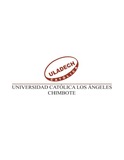| dc.contributor.author | Azañedo Vilchez, Diego Eduardo | |
| dc.contributor.author | Hernández-Vásquez, A. | |
| dc.contributor.author | Casas-Bendezú, M. | |
| dc.contributor.author | Gutiérrez, C. | |
| dc.contributor.author | Agudelo-Suárez, A.A. | |
| dc.contributor.author | Cortés, S. | |
| dc.date.accessioned | 2019-01-23T00:25:56Z | |
| dc.date.available | 2019-01-23T00:25:56Z | |
| dc.date.issued | 2017 | |
| dc.identifier.citation | Azanedo D, Hernandez-Vasquez A, Casas-Bendezu M, Gutierrez C, Agudelo-Suarez AA, Cortes S. Factors determining access to oral health services among children aged less than 12 years in Peru. F1000Research. 2017;6:1680. | es_ES |
| dc.identifier.issn | 20461402 | |
| dc.identifier.uri | http://repositorio.uladech.edu.pe/handle/123456789/8667 | |
| dc.description.abstract | Background: Understanding problems of access to oral health services requires knowledge of factors that determine access. This study aimed to evaluate factors that determine access to oral health services among children aged <12 years in Peru between 2014 and 2015. Methods: We performed a secondary data analysis of 71,614 Peruvian children aged <12 years and their caregivers. Data were obtained from the Survey on Demography and Family Health 2014-2015 (Encuesta Demográfica y de Salud Familiar - ENDES). Children's access to oral health services within the previous 6 months was used as the dependent variable (i.e. Yes/No), and the Andersen and col model was used to select independent variables. Predisposing (e.g., language spoken by tutor or guardian, wealth level, caregivers' educational level, area of residence, natural region of residence, age, and sex) and enabling factors (e.g. type of health insurance) were considered. Descriptive statistics were calculated, and multivariate analysis was performed using generalized linear models (Poisson family). Results: Of all the children, 51% were males, 56% were aged <5 years, and 62.6% lived in urban areas. The most common type of health insurance was Integral Health Insurance (57.8%), and most respondents were in the first quintile of wealth (31.6%). Regarding caregivers, the most common educational level was high school (43.02%) and the most frequently spoken language was Spanish (88.4%). Univariate analysis revealed that all variables, except sex and primary educational level, were statistically significant. After adjustment, sex, area of residence, and language were insignificant, whereas the remaining variables were statistically significant. Conclusions: Wealth index, caregivers' education level, natural region of residence, age, and type of health insurance are factors that determine access to oral health services among children aged <12 years in Peru. These factors should be considered when devising strategies to mitigate against inequities in access to oral health services. © 2017 Azañedo D et al. | es_ES |
| dc.format | application/pdf | es_ES |
| dc.language.iso | eng | es_ES |
| dc.publisher | Universidad Católica los Ángeles de Chimbote | es_ES |
| dc.relation.isPartOf | F1000Research | es_ES |
| dc.rights | info:eu-repo/semantics/restrictedAccess | es_ES |
| dc.source | Center of Research on Population, Universidad Católica los Ángeles de Chimbote (ULADECH-Católica), Chimbote, 02800, Peru | es_ES |
| dc.source | Universidad Privada del Norte, Lima, 15434, Peru | es_ES |
| dc.source | Grupo de Modelamiento Matemático y Simulación Numérica, Universidad Nacional de Ingeniería, Lima, Peru | es_ES |
| dc.subject | Oral Health | es_ES |
| dc.subject | Dental Caries | es_ES |
| dc.subject | Caries ECC | es_ES |
| dc.title | Factors determining access to oral health services among children aged less than 12 years in Peru | es_ES |
| dc.type | info:eu-repo/semantics/article | es_ES |
| dc.identifier.journal | Elsevier | es_ES |
| dc.subject.ocde | https://purl.org/pe-repo/ocde/ford#3.02.14 | es_ES |

